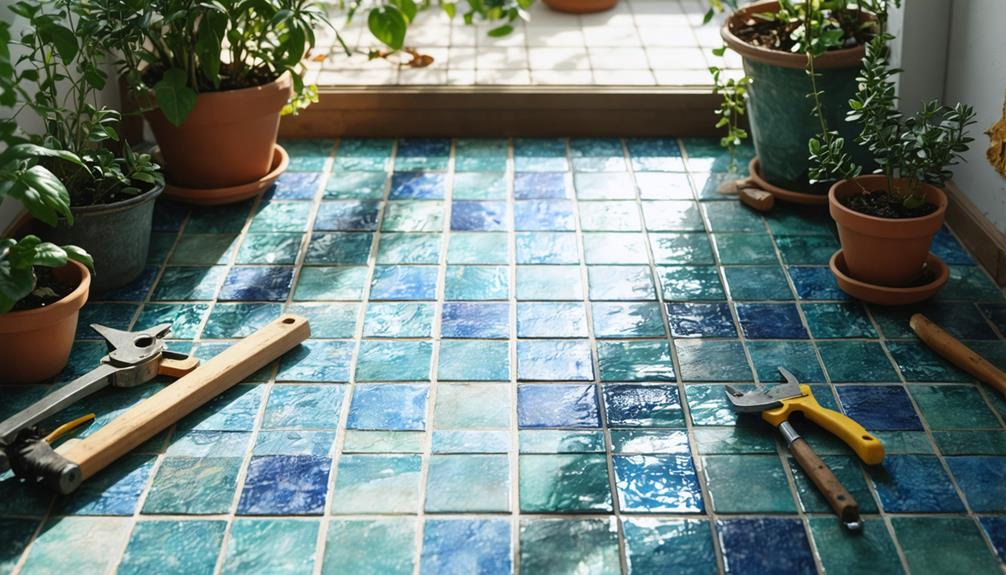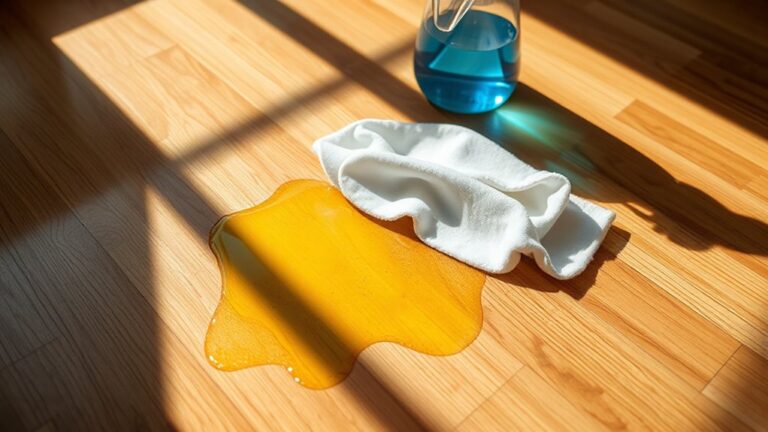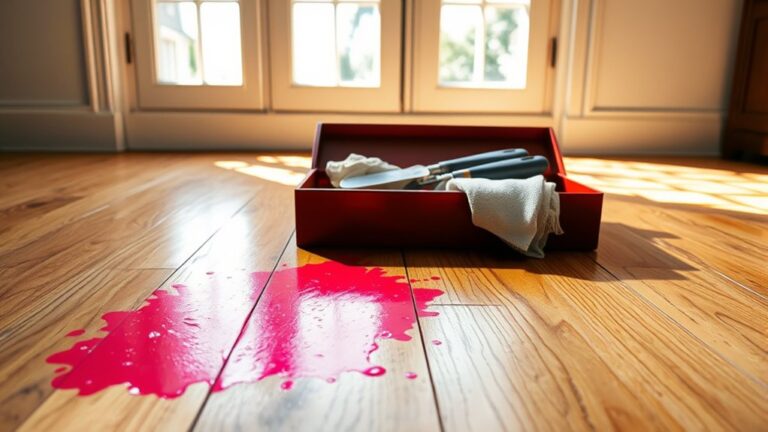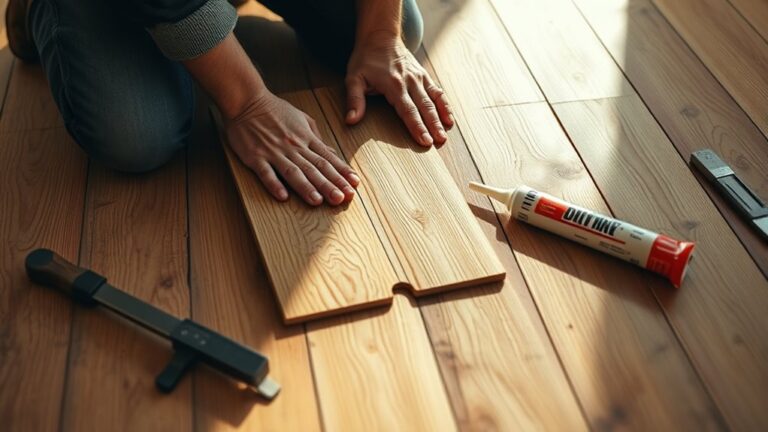When you're ready to install recycled tile flooring, start by prepping your subfloor to guarantee it's clean and stable. Use sustainable adhesives with low VOCs for a healthier home environment. Plan your tile layout for minimal waste and dry fit the tiles to visualize the look. Employ energy-efficient tools to save on costs and reduce your carbon footprint. Don't forget to choose eco-friendly grouts that minimize pollutants. Allow adequate curing time for your newly installed tiles, and maintain them regularly to prolong their life. There's a wealth of tips that can help you achieve your stunning, sustainable flooring goals.
Benefits of Recycled Tile Flooring
When you consider flooring options, recycled tile flooring stands out for its remarkable blend of durability and style. Imagine stepping onto a surface that not only complements your aesthetic vision but also champions sustainability. Recycled tiles are crafted from materials that would otherwise end up in landfills, promoting a circular economy that resonates with your desire for freedom and environmental stewardship.
One of the standout benefits of these sustainable tiles is their impressive longevity. You can expect recycled tile flooring to outlast many traditional choices, often lasting decades longer. This durability means fewer replacements, which greatly reduces your overall environmental impact. Plus, the manufacturing process for these tiles uses less energy and water, making your choice even more eco-friendly.
But it doesn't stop there. Your indoor air quality will thank you! Recycled tiles are often free from harmful substances, such as VOCs, that are commonly found in conventional materials. This means a healthier living space for you and your loved ones, allowing you to breathe easy while enjoying your stylish environment.
With a variety of unique designs and textures, incorporating recycled tiles into your home enhances its character and charm. Whether you prefer a sleek modern look or something more rustic, there's a perfect match waiting for you. By choosing recycled tiles, you're not just flooring your space; you're making a statement that embraces both beauty and responsibility. Embrace the freedom to create a stunning, sustainable sanctuary!
Preparing the Subfloor
Before laying down your stunning recycled tile, you'll want to take a close look at your subfloor's condition. Make sure it's clean and level, as any imperfections could jeopardize your tile's performance and beauty. A solid foundation not only enhances adhesion but also elevates the entire aesthetic of your space.
Assess Subfloor Condition
Consistently ensuring your subfloor is in top condition is essential for a successful recycled tile flooring installation. Start by checking for any moisture issues, as excess moisture can be a silent enemy. Conduct a moisture test to catch potential problems before they lead to mold growth or compromise your beautiful tiles.
Next, inspect for structural damage. Look for cracks or weak spots in the subfloor that could undermine your installation methods. If you spot any flaws, don't hesitate to repair them. A stable foundation is key to the longevity of your tiles.
Leveling is vital too. Your subfloor should have no more than 1/8 inch of deviation over a 10-foot span. Uneven surfaces can result in cracked or dislodged tiles, ruining your aesthetic dreams.
Clean and Level Surface
To achieve a flawless installation of recycled tile flooring, starting with a clean and level surface is paramount. You want your subfloor to be free of debris, dust, and contaminants, as these can hinder strong adhesion. Check for any uneven areas using a level, and repair discrepancies to create a flat surface that guarantees ideal tile placement.
Fill in cracks and holes with a suitable leveling compound, preventing future tile movement and damage. Remember, moisture testing is essential—high humidity can impact adhesive performance. Aim for a moisture level below 4%. Allow any repair materials to cure fully according to manufacturer instructions before proceeding with your installation.
Here's a quick reference table to guide you:
| Task | Importance | Tools Needed |
|---|---|---|
| Remove debris and dust | Promotes strong adhesion | Broom, vacuum |
| Check for unevenness | Guarantees flat surface | Level |
| Fill cracks and holes | Prevents tile movement | Leveling compound, trowel |
| Moisture testing | Guarantees proper adhesion | Moisture meter |
Choosing Sustainable Adhesives
When it comes to installing recycled tile flooring, choosing the right adhesives can make a significant difference in both your health and the environment. Opting for sustainable adhesives is an empowering choice that minimizes harmful emissions and boosts indoor air quality. Look for low-VOC or no-VOC options; these eco-friendly choices are designed to protect you and your loved ones from toxic solvents often found in traditional adhesives.
Many sustainable adhesives are crafted from natural materials and are incredibly effective across various tile types. They create robust bonds while still being gentle on the planet. Water-based adhesives, in particular, stand out for their ability to lower your carbon footprint, as they generally require less energy during production compared to solvent-based alternatives. Plus, some of these eco-friendly adhesives are made from renewable resources like plant-based materials, enhancing the sustainability of your flooring project.
Choosing sustainable adhesives not only aligns with a greener lifestyle but also contributes to a healthier home environment. Imagine the peace of mind you'll feel knowing that your flooring installation is supporting both your well-being and the planet. It's not just about aesthetics; it's about creating a space that resonates with your values. So, as you commence on this exciting journey of transforming your space with recycled tile, remember: the right adhesive does more than hold tiles in place; it holds your commitment to a healthier, more sustainable future.
Proper Tile Layout Techniques
How do you guarantee your recycled tile flooring installation not only looks stunning but also maximizes efficiency? It all starts with mastering proper tile layout techniques. Before you engage in installation, take the time to create a detailed layout plan. Consider the dimensions of your space and the size of your tiles, along with the desired pattern. This preparation minimizes waste and guarantees a smooth installation process.
Next, establish a reference line from the center of the room; it's your guiding light for a balanced appearance, especially in larger areas where visual alignment is key. Start laying tiles from this center point, working your way outward. This method not only enhances symmetry but also helps conceal any cuts at the edges, guaranteeing a clean finish.
Before you commit to adhesive, dry fit your tiles in the planned layout. This lets you visualize the pattern and make necessary adjustments, avoiding those pesky awkward cuts. Consistency is essential, so maintain even spacing with spacers between tiles. This guarantees professional-quality grout lines, making your recycled tile flooring pop.
With these techniques in hand, you're not just installing flooring; you're creating a beautiful, cohesive space that reflects your style and commitment to sustainability. By embracing these proper tile layout techniques, you'll transform your home into a stunning showcase of recycled artistry.
Using Energy-Efficient Tools
Investing in energy-efficient tools for your recycled tile flooring project isn't just a smart choice; it's a step toward a more sustainable future. By opting for tools that consume less energy, you're not only reducing your carbon footprint but also embracing a lifestyle that values eco-friendly practices. Think about it: ENERGY STAR certified power tools can cut energy consumption by 20-50% compared to their traditional counterparts. That's a significant saving!
When you choose cordless tools, you're eliminating the clutter of power cords and the energy drain from constant electrical outlets. Instead, you can enjoy the freedom of movement, making tile installation a breeze. Plus, these rechargeable batteries mean less waste over time, aligning perfectly with your commitment to sustainable tile solutions.
High-quality, durable tools are also an investment worth making. They'll last longer, which means fewer replacements and repairs, ultimately minimizing waste and energy consumption. You'll find that precision tools not only enhance your craftsmanship but also reduce material waste during the cutting process. This is essential when working with eco-friendly tiles, as every piece counts towards maintaining a sustainable installation.
Minimizing Waste During Installation
When you're installing recycled tile flooring, precision cutting techniques can make a world of difference in reducing waste. By carefully measuring and planning your layout, you can maximize your materials and avoid those frustrating leftover pieces. Plus, don't forget to think creatively about recycling any scraps—those remnants can become unique design elements in your next project!
Precision Cutting Techniques
Achieving a flawless finish with recycled tile flooring hinges on your cutting techniques—after all, precision is key to minimizing waste and maximizing beauty. To get those clean edges, invest in specialized tools like tile saws with diamond blades. They'll help you make accurate cuts while reducing scrap material, which is essential when you're committed to minimizing your environmental impact.
Before you start, take the time to create a detailed layout plan. This strategic cutting method allows you to see where each tile fits best, ensuring you make the most of your materials. Remember, measuring tools and templates aren't just for pros—they're your allies in achieving that polished look.
When it comes to cutting, consider dry cutting or using wet saws. These techniques not only boost efficiency but also cut down on dust, keeping your workspace clean and inviting. Plus, don't forget those leftover pieces! With a bit of creativity, you can repurpose them for future repairs or as decorative accents, further embracing sustainability in your flooring installation. So, gear up, and let's cut with precision!
Recycling Old Materials
Once you've mastered precision cutting, the next step is to focus on recycling old materials to further minimize waste during your tile installation. Embracing sustainable building practices not only benefits the environment but also breathes new life into your design. Salvaging and repurposing old tiles can reduce landfill waste considerably, transforming what could be discarded into beautiful, unique flooring.
Consider incorporating recycled materials like salvaged glass, ceramic, or stone tiles. Not only do these options provide an eclectic aesthetic, but they also highlight your commitment to sustainability. By properly sorting and recycling old tiles, you help prevent emissions linked to the production of new products, supporting local recycling facilities in the process.
Utilizing reclaimed materials adds character and history to your space, creating a story within your home. Imagine the charm of a vintage tile paired with modern elements, striking a balance between the old and the new. With each carefully placed piece, you're not just flooring a room; you're crafting a sustainable sanctuary. So, as you commence on this journey, remember—recycling old materials is a step toward a greener, more stylish future.
Selecting Eco-Friendly Grouts
Selecting eco-friendly grouts is an essential step in ensuring your recycled tile flooring project aligns with your sustainability goals. Choosing the right grout not only enhances the beauty of your tiles but also reflects your commitment to a healthier planet. Start by prioritizing low-VOC (volatile organic compounds) options—these grouts considerably reduce harmful emissions, creating a safer indoor environment for you and your loved ones.
Look for grouts that incorporate recycled materials, like post-consumer glass or ceramic. These innovative products help minimize waste while contributing to your eco-friendly mission. Water-based grouts are often the top choice here; they come with a lower environmental impact and make for a breeze during cleanup.
Don't overlook grout sealers, either! Opt for low-VOC, environmentally friendly sealants that not only protect your stunning tile but also minimize potential pollutants in your home. This thoughtful choice enhances durability while keeping your indoor air quality pristine.
As you embark on this eco-conscious journey, research manufacturers who prioritize sustainability in their grout offerings. Many are now rolling out eco-friendly lines that align with green building practices, ensuring your choices truly reflect your values.
Making these mindful selections during your flooring project isn't just about aesthetics—it's about freedom from harmful chemicals and a step towards a greener future. So go ahead, embrace these eco-friendly grouts, and let your recycled tile flooring shine with purpose!
Allowing for Curing Time
Curing time is a crucial phase in your recycled tile flooring project that shouldn't be overlooked. This period, typically lasting between 24 to 48 hours, is essential for allowing adhesives and grout to set properly, ensuring your stunning new flooring option maintains its integrity. Rushing this process can lead to misalignments and defects, so take a moment to appreciate the importance of patience in this journey.
Here are some key tips to keep in mind during the curing time:
- Maintain Consistent Conditions: Aim for a temperature between 60-80°F and humidity around 30-50% to support ideal adhesion.
- Keep Off the Floor: Avoid walking on your newly installed tiles to prevent dislodging them or compromising the adhesive's effectiveness.
- Seal the Space: Keep windows and doors closed to minimize airflow that could disrupt the curing process.
- Follow Manufacturer Guidelines: Adhering to specific curing time recommendations can greatly enhance the durability of your tiles, reflecting the quality of the manufacturing process.
Maintenance Tips for Longevity
To keep your recycled tile flooring looking fresh and vibrant, establish a regular cleaning schedule that prioritizes non-toxic solutions. Harsh chemicals might promise a quick clean, but they can dull your tiles over time—no one wants that! By treating your floors with care, you'll guarantee they stay stunning and last for years to come.
Regular Cleaning Schedule
Establishing a regular cleaning schedule is essential for maintaining the stunning look and durability of your recycled tile flooring. By committing to a weekly routine, you can prevent dirt and debris from building up, protecting the surface from scratches and keeping it visually appealing.
Here are some key steps to include in your cleaning regimen:
- Sweep or vacuum regularly to eliminate loose particles before mopping.
- Use pH-neutral, non-toxic cleaning solutions to safeguard your tile and grout, while promoting a healthier indoor environment.
- Spot clean high-traffic areas immediately to tackle spills and stains, minimizing the risk of permanent damage.
- Inspect grout lines periodically and apply a low-VOC sealant every few years to fend off moisture and staining.
With this regular cleaning schedule, you'll not only extend the life of your recycled tile flooring but also enjoy a beautiful, sustainable space. Embracing these practices allows you to revel in your home without worrying about harsh chemicals or damaging your investment. So, release your freedom and enjoy your eco-friendly flooring to the fullest!
Avoid Harsh Chemicals
When it comes to maintaining the beauty and integrity of your recycled tile flooring, steering clear of harsh chemicals is key. Using non-toxic, biodegradable cleaners not only protects your investment but also keeps your home eco-friendly. Harsh chemicals like bleach or ammonia can break down the finish and grout, leading to premature wear and tear. Instead, opt for a pH-neutral cleaning solution.
To help you choose the right products, check out the table below:
| Cleaning Product | Effectiveness |
|---|---|
| Non-toxic cleaner | Safe for all surfaces |
| Biodegradable solution | Environmentally friendly |
| pH-neutral cleaner | Gentle on recycled materials |
| Soft mop or cloth | Prevents scratching |
| Regular maintenance | Extends tile life |
Implement a routine maintenance schedule to inspect grout lines and tiles for wear. Address any issues promptly with gentle, eco-friendly products that respect the integrity of your flooring. By avoiding harsh chemicals, you'll guarantee your recycled tile floors remain stunning and last for years to come, embodying the freedom of a sustainable lifestyle.
Hiring Experienced Installers
In the quest for a stunning and sustainable home, hiring experienced installers can make all the difference. The right professionals not only guarantee your recycled tile flooring is laid correctly but also help minimize waste through precise cuts and adjustments. This is essential for achieving the aesthetic appeal you desire while staying eco-conscious.
When seeking out installers, consider these key points:
- Expertise in Sustainable Practices: Look for contractors with a strong background in working with eco-friendly materials. They'll understand the nuances of recycled tiles and how to handle them effectively.
- Knowledge of Low-VOC Products: Experienced installers are familiar with low-VOC adhesives and grouts, which are critical for maintaining healthy indoor air quality.
- Adaptability to Different Materials: Different recycled tile types require specific installation techniques. Skilled installers know how to adapt their methods to guarantee durability and visual appeal.
- Commitment to Sustainable Methods: Engaging professionals who prioritize sustainable installation methods ensures your project aligns with environmentally responsible practices.
Frequently Asked Questions
What Is the Recycled Content of Porcelain Tile?
When you consider porcelain tile, you'll find that it can contain up to 40% recycled content. This not only boosts the eco-friendly options for your space but also enhances recycled porcelain durability. By choosing these tiles, you embrace sustainable design that lessens environmental impact. You're not just flooring your home; you're making a statement about your commitment to the planet, enjoying both style and responsibility in every step you take.
What Tile Is Most Sustainable?
When you're searching for the most sustainable tile, you'll find eco-friendly options that shine with unique character. Recycled glass tiles lead the way, boasting impressive energy efficiency and sustainable sourcing. Then there's reclaimed ceramic, which tells a story while minimizing waste. Don't overlook bamboo, a rapidly renewable resource that grows right before your eyes. Each choice deserves a lifecycle assessment, ensuring your selection aligns with your values and dreams for a greener home.
What Types of Recycled Materials Can Tile and Floors Be Made Of?
When considering recycled materials for tiles and floors, you've got some fantastic eco-friendly options. Think recycled glass, ceramics, and even rubber from old tires. These materials not only promote sustainable sourcing but also bring unique aesthetics to your space. As you explore installation techniques, keep in mind durability factors—like how well these tiles stand up to wear and tear. You're not just choosing a floor; you're embracing a greener lifestyle!




